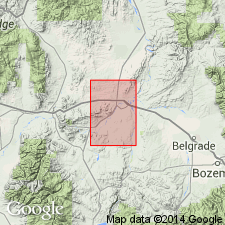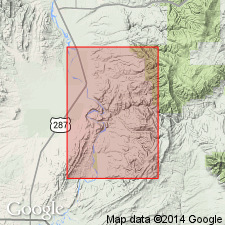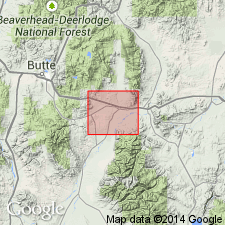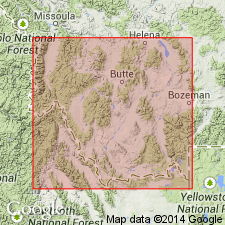
- Usage in publication:
-
- Climbing Arrow formation*
- Modifications:
-
- Named
- Dominant lithology:
-
- Clay
- Sandstone
- Siltstone
- Conglomerate
- AAPG geologic province:
-
- Montana folded belt
Summary:
Named as a formation in the Bozeman group (raised in rank) for Climbing Arrow Ranch, Gallatin Co, MT in the Montana folded belt province. Type area designated in NW cor sec 12, T1N, R1E. Crops out over 27 sq mi; probably underlies 20 sq mi more. Is a sequence of poorly exposed, poorly consolidated clay with subordinate siltstone, sandstone, conglomerate and limestone. Thought to be 750-1000+ ft thick. Total thickness of more than 1500 ft in subsurface. The clay is gray olive, sandy and bentonitic. The sandstone may be thin to thick bedded, pale olive to yellow gray, medium to coarse grained, subangular to subround, feldspathic and biotitic. Limestone beds are finely crystalline and porous. Pebble conglomerates occur as lenses. Is conformably underlain by Milligan Creek formation (new) of Bozeman. Is overlain gradationally by Dunbar Creek formation (new) of Bozeman. Ranges in age from middle or late Eocene to early Oligocene. Has vertebrate (hare, oreodon, etc), freshwater gastropod, wood and leaf fossils. Deposited by an aggrading stream system. Geologic map.
Source: GNU records (USGS DDS-6; Denver GNULEX).

- Usage in publication:
-
- Climbing Arrow Formation*
- Modifications:
-
- Revised
- AAPG geologic province:
-
- Montana folded belt
Summary:
Sixmile Creek Formation named as uppermost formation of Bozeman Group in Big Belt Mountains area, Broadwater and Gallatin Cos, MT, Montana folded belt province. Here, Bozeman consists of (ascending): Climbing Arrow, Dunbar Creek, and Sixmile Creek Formations. Climbing Arrow or Dunbar Creek are disconformably overlain by Sixmile Creek Formation. Cross sections. Oligocene age.
Source: GNU records (USGS DDS-6; Denver GNULEX).

- Usage in publication:
-
- Climbing Arrow Member
- Modifications:
-
- Revised
- Overview
- Areal extent
- AAPG geologic province:
-
- Montana folded belt
Summary:
Extended into Jefferson basin area, southern Jefferson and northern Madison Cos, MT, Montana folded belt province. Rank reduced to member of Renova Formation (new) of Bozeman Group. Crops out sporadically as miniature badlands over 7 sq mi along western margin of basin between Big and Little Pipestone Creeks and immediately south of Little Pipestone Creek, where unit nonconformably overlies granitic rocks of Boulder batholith and is overlain by Quaternary and possibly undifferentiated upper Tertiary deposits. Also exposed east of Whitewall, where overlies Belt rocks with angular unconformity and unconformably underlies Sixmile Creek Formation. Consists of montmorillonite mudstone and lenticular submature arkose. Maximum exposed thickness is about 175 ft. Geologic map, cross sections, correlation chart, fossil list. Early Oligocene (Chadronian) age based on fossil mammals.
Source: GNU records (USGS DDS-6; Denver GNULEX).

- Usage in publication:
-
- Climbing Arrow Formation*
- Modifications:
-
- Not used
Summary:
Historical use of formal stratigraphic nomenclature applied to Bozeman Group in southwest MT, Montana folded belt province described. Charts. Bozeman and its formations --Sphinx Conglomerate (oldest), Milligan Creek, Climbing Arrow, Dunbar Creek, Sixmile Creek of the Toston-Clarkson Valley areas, and the Renova (oldest) and Sixmile Creek Formations of the Jefferson-Beaverhead Valley areas not used. These Tertiary rocks considered to be basin-fill deposits separable on basis of sequence stratigraphic concepts, rather than on lithostratigraphic principles. Lithologic distinctions within the group are not distinctive due to abrupt lateral facies changes. These rocks are separable into 5 sequences, numbered 1 to 5, no. 1 is the oldest; no. 5 is post-Bozeman alluvium. Each sequence is separated by an unconformity. Term unconformity applied in this paper to surfaces of non-deposition or erosion; these surfaces have soils developed on them. Sequence 1 consists of calc-alkalic flows, flow tuffs, tuff, matrix -supported conglomerate, some massive sandstone about 157 m thick, and is of Eocene age. Sequence 2 is mostly fluvial channel conglomerate, sandstone, mudstone, siltstone, and minor tuff, lapilli tuff about 400 m thick, and is of Eocene and Oligocene age. Sequence 3 is fluvial sheet sandstone, some mudstone, siltstone, sandstone, lenses of conglomerate of flood plain origin about 214 m thick, and is of Oligocene and Miocene age. Sequence 4 is mudstone, siltstone, sandstone, lenses of conglomerate mostly of flood plain origin 1,000 m thick, and is of Miocene and Pliocene age. Sequence 5 unconformably overlies rocks that were assigned to Bozeman. Map shows distribution of the 5 sequences. The unconformities can be traced into the subsurface seismically.
Source: GNU records (USGS DDS-6; Denver GNULEX).
For more information, please contact Nancy Stamm, Geologic Names Committee Secretary.
Asterisk (*) indicates published by U.S. Geological Survey authors.
"No current usage" (†) implies that a name has been abandoned or has fallen into disuse. Former usage and, if known, replacement name given in parentheses ( ).
Slash (/) indicates name conflicts with nomenclatural guidelines (CSN, 1933; ACSN, 1961, 1970; NACSN, 1983, 2005, 2021). May be explained within brackets ([ ]).

